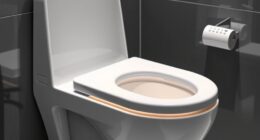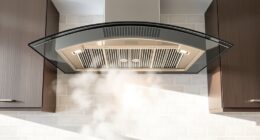Fixing a refrigerator that won't cool can set you back between $200 and $1,300, with the average cost landing around $650. Common culprits may include a faulty compressor, malfunctioning thermostat, or refrigerant leaks. Each issue comes with its own price tag, like thermostat repairs costing $100 to $440 or compressor issues ranging from $200 to $450. The total expense can also depend on factors like labor rates and your fridge's age. If you're curious about how to evaluate your options, keep going to understand more about repair versus replacement and maintenance tips.
Key Takeaways
- Average repair cost for cooling issues in refrigerators is $650, with a range of $200 to $1,300.
- Common causes of cooling failures include faulty compressors, malfunctioning thermostats, and refrigerant leaks.
- Compressor repairs can cost between $200 and $450, while replacement can range from $700 to $1,250.
- Thermostat repairs typically range from $100 to $440; refrigerant leak repairs cost around $200 to $300.
- It's crucial to evaluate repair costs against the age of the refrigerator; models older than 18 years are often better replaced.
Overview of Repair Costs
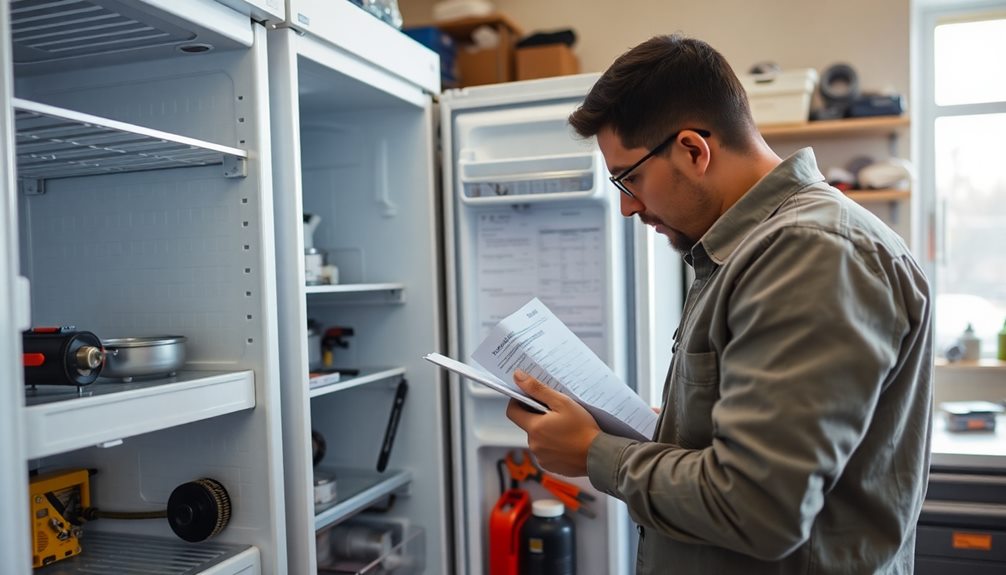
When your refrigerator starts acting up, understanding the costs associated with repairs can save you a lot of headaches. The average repair cost for a refrigerator hovers around $650, with typical expenses ranging between $200 and $1,300.
If you're dealing with a mini fridge, expect similar repair costs averaging $250. National averages for refrigerator repairs generally fall between $300 and $1,000, making it essential to evaluate these figures against the cost of a replacement, which can run from $1,000 to $3,000.
Common repairs like fixing leaks or replacing thermostats tend to be less expensive than buying a new unit, but specific issues can escalate quickly. For instance, compressor failures may lead to repair costs between $500 and $1,000, often prompting you to contemplate replacement as the more economical option.
When planning for repairs, it's wise to get multiple quotes and assess the age and condition of your refrigerator. This way, you can effectively determine if a repair is worth it or if it's time to invest in a new appliance.
Common Refrigerator Issues

When your refrigerator isn't cooling properly, you might be dealing with issues like a faulty compressor or a malfunctioning thermostat.
These common failures can lead to higher repair costs if not addressed quickly.
Let's explore these problems and what you can expect to spend on repairs.
Common Cooling Failures
Cooling problems can sneak up on you, often stemming from common issues that affect your refrigerator's performance.
Here are three common cooling failures to watch for:
- Compressor Issues: A faulty compressor can drastically reduce cooling efficiency, with repair costs ranging between $200 and $450.
- Defective Thermostat: If your thermostat isn't functioning correctly, it can lead to inadequate temperature regulation. Repair costs for this issue typically range from $100 to $440.
- Refrigerant Leaks: These leaks are notorious for preventing your fridge from maintaining the desired temperature. Repairing a refrigerant leak usually costs between $200 and $300.
Additionally, a malfunctioning evaporator fan can disrupt airflow, often requiring professional attention.
You might also notice frost buildup in the freezer, signaling airflow blockage and potential servicing needs.
To avoid these common cooling failures, consider scheduling regular maintenance to catch issues early.
Addressing problems promptly not only saves you money in the long run but also extends your refrigerator's lifespan.
Don't let cooling issues sneak up on you—stay proactive!
Repair Cost Estimates
Understanding repair cost estimates for common refrigerator issues can save you both time and money.
If your fridge isn't cooling, you might face repair costs ranging from $200 to $1,300, with the average refrigerator repair cost around $650. Common problems like a faulty thermostat can cost between $100 and $440 to fix, while a compressor replacement can set you back $200 to $450.
If a freon leak is the culprit, repairs usually fall between $200 and $300. It's essential to highlight that diagnostic fees for pinpointing cooling issues typically range from $60 to $100. However, these fees are often waived if you proceed with the necessary repairs.
When you suspect a major component failure, such as a bad compressor, you could be looking at repair costs between $500 and $1,000. In older models, it might be more cost-effective to evaluate whether to repair or replace the entire unit.
Specific Repair Costs
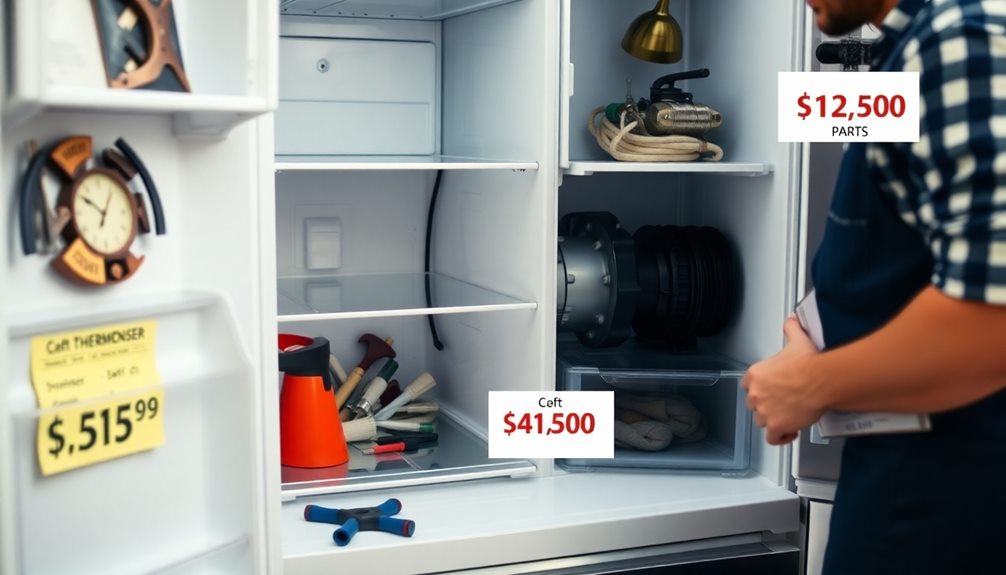
When your refrigerator isn't cooling properly, understanding the specific repair costs can save you time and money.
Common issues like compressor failures or thermostat malfunctions can vary widely in price, depending on whether you choose a professional fix or attempt a DIY solution.
Let's break down the costs you might encounter for these repairs.
Common Cooling Issues
Experiencing common cooling issues in your refrigerator can be frustrating, and knowing the potential repair costs can help you make informed decisions. Here are three common problems you might face:
- Faulty Refrigerator Compressor: Repair costs typically range from $200 to $450, but if it needs replacement, expect to pay between $700 and $1,250.
- Refrigerant Leaks: These can severely impact cooling performance, with repairs usually costing around $200 to $300.
- Malfunctioning Thermostat: If your thermostat isn't regulating temperatures correctly, repair costs can average between $100 and $440.
Additionally, control board failures can also affect cooling efficiency, with an average repair cost of approximately $440, and some cases can even reach up to $800.
Issues like a defective evaporator fan can lead to cooling failure, costing you around $250 to $400.
Understanding these costs can help you assess the situation and determine the most cost-effective solution for your refrigerator's cooling issues.
Always consider getting a professional diagnosis to pinpoint the exact problem and avoid unnecessary expenses.
Repair Cost Estimates
Repairing a refrigerator can often feel overwhelming, especially when you're faced with unexpected costs. When your fridge won't cool, understanding repair cost estimates can help you budget effectively.
For refrigerant leak repairs, you might spend between $200 to $300. If you need compressor replacements, expect costs to range from $200 to $450. Control board repairs, essential for maintaining cooling functionality, typically average around $440 but can be as low as $80 or as high as $800 based on the specifics of the issue.
If the thermostat is malfunctioning, thermostat repairs generally run between $100 and $440. On average, the total repair cost for a refrigerator that won't cool falls within a national average of $300 to $1,000, varying with the complexity of the repair needed.
Additionally, if the evaporator fan motor needs replacing, costs can average between $250 to $400, directly impacting your fridge's cooling performance. By knowing these figures, you can make more informed decisions when addressing your refrigerator's issues and avoid surprises when it's time to pay the bill.
Professional vs. DIY Solutions
Deciding between professional repairs and DIY solutions for your refrigerator can considerably impact your wallet. Here are three key factors to evaluate:
- Repair Costs: Professional repairs can range from $200 to $800, with common issues like thermostat replacements averaging around $440.
- DIY Potential: If you're handy, DIY repairs for minor cooling issues, such as cleaning condenser coils, can cost under $100, saving you on labor.
- Complexity of the Problem: If your fridge faces a serious issue like compressor failure, repair costs can soar from $500 to $1,000, often making replacement a better option.
For minor problems, like fixing a faulty fan or door seal, you might spend between $50 and $440, depending on whether you choose a repair technician or tackle it yourself.
However, remember that repairing a refrigerant leak—a common cause of cooling failure—will typically run you between $200 and $300 if done by a professional.
Ultimately, weighing the potential savings of DIY repairs against the reliability of hiring a professional repair technician can help you make the best decision for your fridge repairs.
Factors Influencing Repair Costs

When your refrigerator starts to malfunction, understanding the factors that influence repair costs can help you budget effectively.
One major factor is labor costs, which typically range from $45 to $120 per hour. You'll also face a service fee that can run between $150 and $200. These fees vary depending on the appliance repair specialist you choose, especially if you opt for factory-authorized technicians to maintain warranty coverage.
The type of repair needed plays a vital role in the final bill. For example, a control board repair averages around $440, while compressor replacements can cost anywhere from $200 to $450.
Additionally, the age and model of your refrigerator can greatly affect repair costs. Older or less common models may require more expensive parts or specialized labor, which could increase your overall expenses.
Don't forget about diagnostic fees, which usually range from $60 to $100. These fees may be waived if you agree to the repairs.
Repair vs. Replace Decisions

Facing a malfunctioning refrigerator often leads to the tough choice between repairing it or replacing it altogether. Here are three key factors to weigh:
- Age of the Appliance: If your refrigerator is older than 18 years, it's usually better to replace it, as appliance repair costs can exceed its value.
- Cost of Repairs vs. Replacement: If the cost to fix exceeds half the price of a new unit, it often makes more sense to replace. For instance, a compressor failure may cost between $500 and $1,000—considerably more than a new refrigerator's cost.
- Type of Refrigerator: Side-by-side and bottom-freezer models under 5 and 7 years old, respectively, are generally worth repairing due to lower appliance repair costs compared to buying new.
Ultimately, your repair vs. replace decisions should hinge on the average lifespan of your fridge, the cost to fix, and whether repairs are worth it.
DIY Repair Potential

If your refrigerator isn't cooling, there are several common DIY repairs you can tackle, like cleaning the condenser coils or unclogging drain lines.
However, it's essential to take into account safety and know when to call in a professional for more complicated issues, like refrigerant leaks.
Common DIY Repairs
Many homeowners can tackle common DIY repairs for a refrigerator that won't cool effectively.
These repairs can save you money and restore your fridge's function without needing a professional. Here are three straightforward fixes you can try:
- Cleaning the condenser coils: Dust and debris can gather on coils, leading to cooling issues. This task is free and can dramatically improve efficiency.
- Replacing a faulty thermostat: If your fridge isn't cooling, the thermostat might be the culprit. With the right tools and instructions, you can manage this DIY project yourself, avoiding the $100 to $440 technician fee.
- Checking door seals: Verify the door seals are intact. Gaps can let cold air escape, causing the refrigerator to struggle with cooling.
Additionally, addressing minor electrical issues, such as resetting the refrigerator or checking the power supply, can often resolve problems.
By taking on these common DIY repairs, you can enhance your fridge's performance and extend its lifespan without breaking the bank.
Safety Considerations
When tackling DIY refrigerator repairs, safety should always come first. Unplugging the refrigerator is essential before attempting any maintenance to prevent electric shock. While minor issues like cleaning coils or unclogging drain lines can often be fixed in about an hour, you need to assess the repair's complexity. Complicated repairs, such as refrigerant leaks or sealed system issues, require certified professionals to guarantee safety and compliance with regulations.
Additionally, you should consider manufacturer warranties. DIY repairs that aren't performed according to guidelines can void your warranty, leaving you with unexpected costs down the line.
Here's a quick reference table to help you navigate DIY repairs safely:
| Repair Type | Safety Considerations | Recommended Action |
|---|---|---|
| Minor Repairs | Always unplug the fridge | DIY if you're confident |
| Cleaning Coils | Use gloves and tools | DIY if you follow guidelines |
| Drain Line Issues | Check for water and electrical hazards | DIY if simple |
| Complicated Repairs | Requires specialized knowledge | Hire a professional to fix |
When to Consult Professionals
Determining whether to tackle a refrigerator repair on your own or call in a professional can greatly impact both your time and wallet. Here are three key points to evaluate:
- Minor Issues: Simple problems like cleaning coils or unclogging defrost drains can usually be fixed in about an hour, saving you money on service fees.
- Common Repairs: Issues such as broken lights or faulty ice makers often don't require professional help and can be handled quickly.
- Complex Problems: For serious issues like refrigerant leaks or compressor failures, it's best to call a professional, as they need specialized knowledge and tools.
While DIY repairs can save money, remember that improper handling can void warranties and pose safety risks.
Regular maintenance can help you catch minor problems early and extend the life of your refrigerator.
If you find yourself unsure about how much it costs for repairs or if you should fix a refrigerator yourself, weigh the average cost of professional refrigerator repair services against the potential risks.
In the end, knowing when to consult professionals can save you both time and hassle.
Lifespan and Maintenance Tips
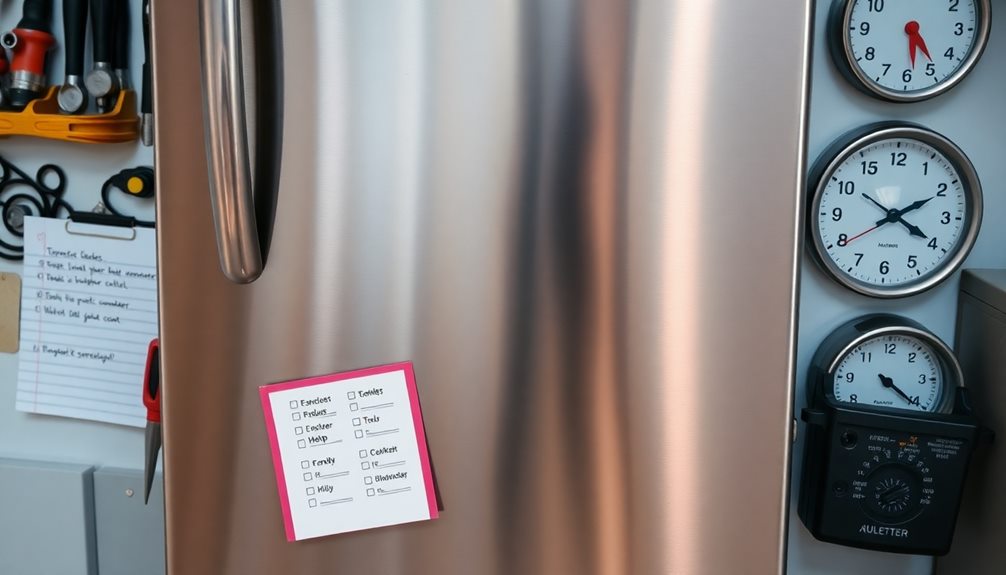
A refrigerator is a significant investment in your home, and understanding its lifespan and maintenance can save you money in the long run. The average lifespan of a refrigerator ranges from 10 to 20 years, depending on how well you maintain it. Regular maintenance can help prevent common issues and extend your appliance's life.
Here are some essential maintenance tips to keep your refrigerator well-maintained:
| Maintenance Task | Frequency |
|---|---|
| Clean condenser coils | Every 6 months |
| Inspect door seals | Every 3 months |
| Check temperature settings | Monthly |
| Defrost if it's a manual model | As needed |
| Schedule professional servicing | Annually |
Maintaining a consistent temperature between 35 to 38 degrees Fahrenheit enhances cooling efficiency and prolongs your refrigerator's lifespan. Additionally, addressing minor issues early can prevent major repairs down the line, making your appliance more cost-effective. If you keep up with these tasks, your refrigerator can function effectively for 15 years or more, maximizing your investment's value.
Getting Professional Estimates

Getting professional estimates for refrigerator repairs is essential to guarantee you're making informed decisions. Here are three key points to contemplate when seeking estimates:
- Diagnostic Fees: Expect to pay between $60 to $100 for a service call to diagnose the issue. This fee might be waived if you agree to the repairs.
- Compare Estimates: It's wise to gather at least three bids from licensed and insured technicians. This helps ensure you're getting quality service and reasonable pricing for the cost to repair.
- Labor Costs: Labor costs typically range from $45 to $120 per hour. Additionally, service fees usually fall between $150 to $200, which you'll need to factor into your total expense.
Before any work begins, request a detailed written estimate. This can help avoid unexpected charges and ensure transparency throughout the appliance repair process.
Customer Service Insights

Customer service experiences often reveal that technicians arrive on time and resolve issues efficiently, sometimes in under 30 minutes. This level of efficiency is a hallmark of Reliable Appliance, a trusted provider in Alaska since 1995.
Many customers appreciate the courteous and knowledgeable demeanor of the technicians, which greatly enhances overall customer satisfaction. Additionally, just as in divorce for financial reasons, clear communication is key to a positive service experience.
Customers often mention the pre-visit calls and timely updates on arrival times, ensuring you're never left in the dark about when help will arrive. This proactive approach not only builds trust but also sets the tone for a smooth interaction.
Reliable Appliance's commitment to customer service goes beyond just fixing your refrigerator. They honor warranty commitments and provide refunds when necessary, demonstrating their dedication to customer loyalty.
With a Google rating of 4.7, it's clear that clients feel valued and respected.
Cost-Effective Solutions

When your refrigerator starts acting up, knowing how to tackle repairs cost-effectively can save you significant money. Here are three strategies to evaluate:
1. Prioritize Regular Maintenance: Keeping your refrigerator clean and in good condition can prevent many common repairs.
Regularly clean the condenser coils and check door seals to avoid cooling issues.
2. Assess the Age of Your Unit: If your refrigerator is under 10 years old, it's often more cost-effective to repair it rather than buy a new one.
Repairs typically cost less than half the price of a new unit, making it a smart financial choice.
3. Choose Common Repairs Wisely: Repairs like replacing the thermostat or evaporator fan can range from $100 to $440.
If you need to repair a refrigerator, focus on these common issues to keep costs down.
Frequently Asked Questions
How Much Does It Cost to Fix a Fridge That Won't Get Cold?
If your fridge won't get cold, you're looking at repair costs between $200 and $650. Common issues include compressor failures or refrigerant leaks. It's wise to weigh repair costs against a new unit's price.
Can You Fix a Refrigerator That Is Not Cooling?
Your refrigerator's silence can be unsettling, but you can fix it. Check for simple issues like dust or door seals. If problems persist, calling a technician might save your food—and your peace of mind.
Is It Worth It to Fix a Refrigerator?
You'll find it often worth fixing your refrigerator, especially if it's under ten years old. Weigh repair costs against buying new, considering the appliance's age and condition to make the best decision.
What Is the Most Expensive Thing to Fix on a Refrigerator?
The most expensive repair on a refrigerator is usually the compressor replacement. It can cost between $700 and $1,250. If you're facing this issue, it is crucial to weigh repair costs against purchasing a new unit.
Conclusion
In the world of appliance repairs, a refrigerator that won't cool can feel like a ticking time bomb for your groceries. By understanding the costs and common issues, you can make informed choices that save you both time and money. Remember, whether you decide to repair or replace, investing a little in maintenance can extend your fridge's life considerably. Don't let a small problem turn into a big expense—act quickly and keep your cool!







